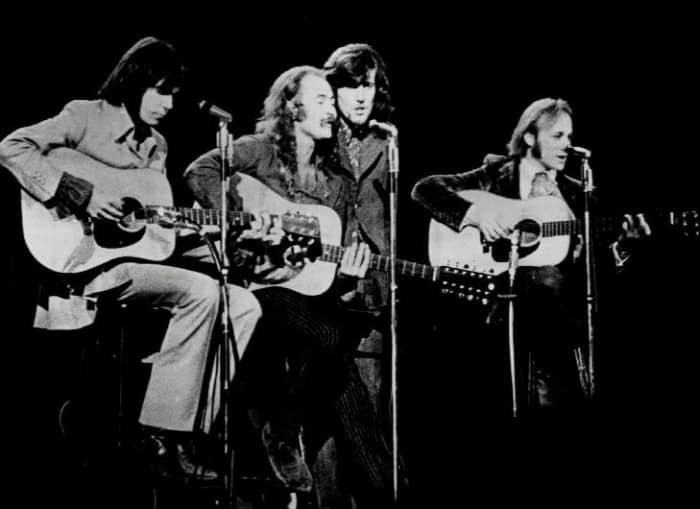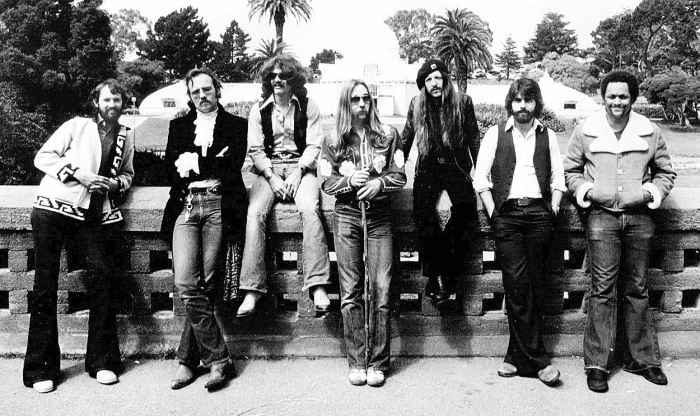100 Best Soft Rock Artists

L–R: Neil Young, David Crosby, Graham Nash, and Stephen Stills. CSNY may have been the first soft rock band, a genre marked by crisp melodies, smooth vocals, and pristine studio production.
Wikipedia Commons
The textural feel and lush production give soft rock a unique identity. Bands and artists associated with this form of music have appealed to listeners across different genres. Since the early '70s, light rock music—popularly known as soft rock—has had mainstream success thanks to its well-defined melodic structure supplemented with smooth vocal techniques and pristine studio production.
Although this micro genre has metamorphosed stylistically in every decade, the sound remains dynamically rooted in pop-rock tradition. The list below showcases a diverse collection of soft rock bands from different decades. If you are a fan of light rock music, you will have a lot to say.
10 Best Soft Rock Artists
- Fleetwood Mac
- Air Supply
- Bee Gees
- Billy Joel
- Crosby, Stills & Nash (& Young)
- James Taylor
- Foreigner
- Chicago
- REO Speedwagon
- Bread
Soft Rock Music Emerges in the 1960s
The sounds of soft rock made their way onto the music scene in the ‘60s. As the folk movement diversified, numerous bands and artists adopted folk tradition in an aesthetically stylish pop-rock avatar. The catchy musical structures infused with hypnotic melodic vocal harmonies became the signature identity in this musical experimentation.
To give their musical concepts a flourish, certain acts started incorporating a high degree of finesse to sound processing in the studio thereby taking the dynamics of music production to a whole new level. This lush production-oriented music format gradually paved the way for diverse soft rock acts. Some of the early soft rock bands and artists were known for their catchy rhythm structures combined with intricate vocal harmonies in the chorus or verse of songs.
#11—20
11. The Carpenters
12. England Dan & John Ford
13. Neil Diamond
14. Seals and Crofts
15. Elton John
16. Pablo Cruise
17. 10cc
18. Eric Carmen
19. Eagles
Recommended
20. Chris Rea

Fleetwood Mac became the greatest soft rockers of all time when Stevie Nicks (second from right) and Lindsay Buckingham (far right) joined the band in 1975.
Wikipedia Commons
Soft Rock Goes Mainstream in the '70s
With musicians in pop and rock genres adopting mellow sounds in their musical compositions, softer songs came to the forefront. As softer sounds became authoritative in pop-rock styles, soft rock came into mainstream prominence.
In the ‘70s, several rock-oriented acts with defining pop elements in their music had tremendous chart-topping success with their songs. While soft rock bands from the US displayed their characteristic pop laden rock sound, their European counterparts became widely known for their smoothed-out pop-rock ballads.
Soft rock songs became widely popular on radio formats in the ‘70s. Several acts associated with light rock became hugely popular on Adult contemporary stations. With soft rock reaching its commercial peak in the ‘70s, several major record labels started signing and promoting upcoming acts associated with the genre.
Mellow rock bands with their distinctive polished sound encompassed with diverse aspects of balladry found considerable success in the decade.
#21—40
21. Stevie Nicks
22. Journey
23. Dr. Hook & the Medicine Show
24. Player
25. Barry Manilow
26. Ambrosia
27. Hootie & the Blowfish
28. Steely Dan
29. John Mayer
30. Hall & Oates
31. Five for Fighting
32. Chad & Jeremy
33. Smokie
34. Captain & Tennille
35. Wings
36. Stephen Bishop
37. Little River Band
38. Atlanta Rhythm Section
39. The Fray
40. The Doobie Brothers

The Doobie Brothers (pictured here in 1977) were pioneers of yacht rock, a subset of soft rock that emphasized danceable grooves as much as melody.
The Rise of Yacht Rock
Yacht rock, a musical style with a broad spectrum of influences and aesthetics came to the forefront through the soft rock movement in the ‘70s. In the early ‘70s certain soft rock bands started experimenting with their sound by adding varying progressive soundscapes from both mainstream and non-mainstream genres.
This musical exploration shaped the yacht rock sound. While light rock bands showcased a diverse pop-rock musicality in their songs, yacht rock acts also incorporated elements of smooth jazz, R&B, disco, and smooth soul in their compositions. While yacht rock employed similar stylistic traits such as high-quality production and catchy melodies, what differentiated yacht rock from soft rock was the broad spectrum of musical influences from non-mainstream genres.
Introspective Individualism
Yacht rock represented a form of introspective individualism that came into prominence after the mass-movement idealism of the ‘60s faded. Several yacht rock artists collaborated with artists from pop and rock genres to create a sophisticated pop-rock blend of songs.
Although yacht rock closely associated with different styles of soft rock, it emphasized more on a groove-based melody with a saccharine-like honesty with lyrics. The light emotions expressed in different yacht rock songs resonate an anthemic quality with a feelgood bounce in the chorus and verse of songs.
#41—60
41. Toto
42. Art Garfunkel
43. Harry Nilsson
44. The Alan Parsons Project
45. Carly Simon
46. Carole King
47. John Denver
48. Leo Sayer
49. America
50. Olivia Newton-John
51. Kenny Loggins
52. Savage Garden
53. Mike and the Mechanics
54. Roxette
55. Styx
56. David Gates
57. Poco
58. Cat Stevens
59. Jackson Browne
60. Harry Chapin

Few artists better embody '80s soft rock than Air Supply. "Lost in Love" was the first of eight Top 5 singles for the duo between 1979 and 1983.
Soft Rock Evolves in the 1980s and ‘90s
Soft rock evolved a great deal in the ‘80s. As new sounds emerged in the decade, a great number of soft rock artists transitioned their music style in a new direction. Incorporating ultra-urban synthesized sounds and equipped with a new wave of influences these bands and artists reinvented the sound of light rock music.
While glam metal became the defining moment of the ‘80s, a fair share of soft rock bands had chart-topping success. Different types of ballads became hugely popular in the decade. Several glam metal bands started being associated with soft rock for their hard-edged rock love songs. Soft rock bands in the ‘80s created a unique identity for themselves with their sentimental ballads.
With the dawn of the ‘90s, soft rock manifested itself in mainstream in different ways. Certain alternative acts and indie pop acts of the decade started being identified with soft rock because of the pop-centric rock sounds. Certain hard rock bands and glam metal bands had a great deal of commercial success with their soft rock singles early in the decade.
Alongside alternative and grunge, acoustic rock in the ‘90s had a distinctively unique sound that changed the soft rock blueprint in the decade. Different types of acoustic rock love songs and guitar ballads became excessively popular in the soft rock domain in the ‘90s.
#61—80
61. Richard Marx
62. Jack Johnson
63. Bonnie Tyler
64. Wet Wet Wet
65. Jim Croce
66. Three Dog Night
67. Amy Grant
68. Roxy Music
69. Todd Rundgren
70. Genesis
71. Alessi Brothers
72. Supertramp
73. Paul Anka
74. Al Stewart
75. Christopher Cross
76. Climax Blues Band
77. Andrew Gold
78. Firefall
79. Sad Café
80. Crowded House

James Blunt became the face of soft rock in the 2000s as songs like "You're Beautiful" (2005) and "1973" (2007) were inescapable on radio.
Wikipedia Commons
Soft Rock in the 21st Century
The 2000s ushered a new era of musical soundscapes for soft rock. As electronic sounds came into the mainstream, the musical landscape changed dramatically. Emerging bands and artists associated with pop music and rock music started incorporating diverse elements of EDM in their scheme of things.
Several synthpop, dance-pop, and electropop artists started infusing elements of soft rock in their dance-oriented tunes to create a diverse ambience of sounds. This dance-flavored music with stylistic elements from different genres became hugely popular with urban audiences.
Soft Rock Mixing with Electronica
Since the 2010s, the sound of soft rock has been dominated by pop rock and alternative bands. Acoustic-laced pop punk ballads have become exceedingly popular in alternative genres. In present times, a subtle mix of acoustic folk, dance, and rock combined with eclectic electronic elements has become popular with new bands and artists.
Breathy techniques interspersed with whisper-vocal delivery are showcased in unique ways in modern soft rock songs. Considering the radio-friendly sound of soft rock, one can say this format is only going to get bigger in the days ahead.

